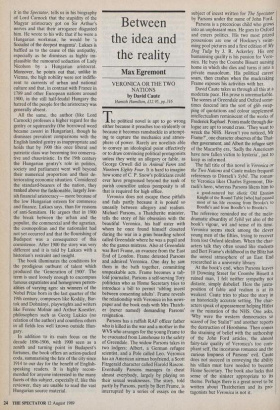Outstanding capital growth
Liliana Brisby
BUDAPEST 1900 by John Lukacs
Weidenfeld & Nicolson, £16.95, pp.255
ei■_ In 1907 a group of British members of the House of Commons known for their pro-Hungarian sympathies went on an official visit to Budapest. Not content to be wined and dined by the government, some of them ran up large bills including a beanfeast at a famous licensed luxury brothel, which they insisted be charged to their hosts. Not surprisingly, an unpleasant scandal ensued. This amusing information is tucked away in a footnote to the author's serious discoufse on the widespread pros- titution in Budapest around 1900. On the whole John Lukacs, a native of Budapest who is now a professor of history in Pennsylvania, tends to eschew obvious splashes of colour for a more thoughtful portrait of the physical city and its material conditions, its people and their politics, their intellectual and artistic culture and their psychological make-up. Yet he is equally able to evoke with a few telling strokes the highpoints in the life of what used to be one of Central Europe's most glittering capitals.
One such set piece is the 1900 mammoth funeral of the expatriate painter Mihaly Munkacsy, a national hero whose star rose briefly in the Parisian artistic firmament but who laboured in vain to debunk the `exaggerations' of the Impressionists. Another is the evocation of the splendid celebration of the Hungarian millenium in 1896, commemorating Prince Arpad's ride into Hungary from the east at the head of the Magyar tribes. Francis Joseph I and the popular Empress-Queen Elizabeth came from Vienna for the occasion, which is described with great flair: `green-trousered heralds blowing silver trumpets', the Habs- burg Emperor in Hungarian hussar uni- form riding with his 'melancholy' consort in Maria Theresa's 'crystal-paned baroque coach', their daughter, the archduchess Stephanie, clicking one of the first Kodak box cameras seen in Budapest, oxen broiled on giant spits for the populace, a real military balloon ascending over a fake Transylvanian castle specially erected on the shores of the lake in the City Park . . .
Between the birth of the Dual Monarchy in 1867 and the first world war Budapest was the fastest growing city in Europe, outpacing by the turn of the century Rome, Madrid, Lisbon, Brussels, Hamburg, Liverpool and Amsterdam. Its extraordin- ary rise was linked to the great force of Hungarian nationalism which had ex- ploded in the 1848-49 revolution, when Buda and Pest were occupied by Austrian armies and 12 Hungarian generals were hanged after the collapse of the rising. Twenty years later, Hungary was offered home rule and the official name of the Austrian Empire became Austria- Hungary. In 1892 an imperial and royal decree merged the largely German- speaking, conservative Buda and the radic- al Magyar Pest (where Kossuth had started the revolution) into Budapest, equal in rank to Vienna.
The same year saw the end of Arthur Nicolson's self-confessed 'four years of boredom' as Consul-General in Budapest. Harold Nicolson, who shared his father's poor opinion of the Hungarians and vented it in the Spectator, tells us in his biography of Lord Camock that the stupidity of the Magyar aristocracy got on Sir Arthur's nerves and that their arrogance disgusted him. He wrote to his wife that if he were a Hungarian workman, he would be 'a Socialist of the deepest magenta'. Lukacs is baffled as to the cause of this antipathy, especially as he dismisses as highly im- plausible the rumoured seduction of Lady Nicolson by a Hungarian aristocrat. Moreover, he points out that, unlike in Vienna, the high nobility were not indiffe rent to currents of urban and national culture and that, in contrast with France in 1789 and other European nations around 1900, in the still half-feudal Hungary the hatred of the people for the aristocracy was generally absent.
All the same, the author (like Lord Carnock) professes a higher regard for the gentry or squirearchy (the borrowed word became zsentri in Hungarian), though he dismisses prevalent comparisons with the English landed gentry as inappropriate and holds that by 1900 this once liberal and patriotic class was becoming too conserva- tive and chauvinistic. In the 19th century the Hungarian gentry's role in politics, society and parliament went well beyond their numerical proportion and their de- teriorating economic situation. Considered the standard-bearers of the nation, they ranked above the fashionable, largely Jew- ish financial aristocracy — more because of the low Hungarian esteem for commerce and finance, Lukacs says, than for reasons of anti-Semitism. He argues that in 1900 the break between the urban and the populist, the commercial and the agrarian, the cosmopolitan and the nationalist had not yet occurred and that the flourishing of Budapest was a consequence of this coexistence. After 1900 the story was very different and it is told by Lukacs with a historian's restraint and insight.
The book illuminates the conditions for the prodigious outburst of talent which produced the 'Generation of 1900'. The term is used loosely enough to encompass famous expatriates and homegrown person- alities of varying ages: six winners of the Nobel Prize born in the last quarter of the 19th century, composers like Kodaly, Bar- tok and Dohnanyi, playwrights and writers like Ferenc Molnar and Arthur Koestler, philosophers such as Georg Lukacs (no relation of the author) and countless others in all fields less well known outside Hun- gary.
In addition to its main focus on the decade 1896-1906, with 1900 seen as a zenith and turning point in Budapest's fortunes, the book offers an action-packed coda, summarising the fate of the city since 1914 to our day for the benefit of English- speaking readers. It is highly recom- mended for anyone interested in the many facets of this subject, especially if, like this reviewer, they are unable to read the vast Hungarian source material.











































 Previous page
Previous page